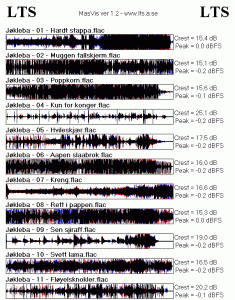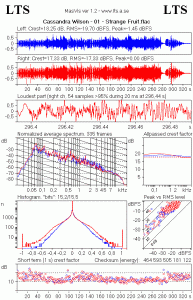Be Aware of Dynamic Range and Clipping
Whether youre mastering a whisper-quiet zen flute tone poem or a heavy metal guitar
fest, volume is a key issue. The main tools used in masteringequalization,
compression, limiting, or combinations of theseare all different ways of controlling
aspects of volume. Making decisions about gain levels, dynamic range, and frequency
response is what mastering is all about.
Many artists and producers feel that louder is better. The trend for louder music has
resulted in both ardent fans of high volumes and backlash from audiophiles, a
controversy known as the loudness wars. This is solely an issue with music. Movies, for
example, have very detailed standards for the final mastering volume of a films
soundtrack. The music world doesnt have any such standard, and in recent years the de
facto process has been to make masters as loud as possible. While some feel that overly
loud mastering ruins music by not giving it room to breathe, others feel that the
aesthetic of loudness can be an appropriate artistic choice for particular songs or
albums.
Analog masters traditionally have volume levels set as high as possible, just shy of
oversaturation, to improve the signal-to-noise ratio (SNR). With digital masters, the goal
is to achieve the highest gain possible without losing information about the original file
due to clipping.
With digital files, theres a limit to how loud you can make a track: 0dBFS. Trying to
increase a tracks overall loudness beyond this point results in distortion caused by
clipping and a loss in dynamic range. The quietest parts of a song increase in volume,
yet the louder parts dont gain loudness due to the upper limits of the digital format.
A less obvious issue when setting gain for digital masters can occur on playback.
Whether it's a compressed file like an AAC file or an uncompressed file such as a CD,
digital data goes through several processes to be converted to an analog signal for
playback.
One common process is called oversampling. This upsamples the digital data at four
times the original sample rate to improve the quality of the digital audio signal being
converted to analog. If the original digital audio data is at 0dBFS, oversampling can
result in undesirable clipping. And if the original was already clipped, oversampling can
make it worse. A growing consensus is emerging that digital masters should have a
small amount of headroom (roughly 1dB) in order to avoid such clipping.
In both digital and analog, the highest possible level will vary from track to track,
depending on the material being mastered. Your decision about the volume and
loudness of your tracks is a technical and creative choice. You might decide to take the
listener on a dynamic journey through an album as a complete work, raising and
lowering the volume level across the sequence of tracks to increase the musics
emotional impact. Alternately, you might pursue the loudest possible signal at all times.
Whatever you decideexquisitely overdriven and loud, or exquisitely nuanced and
tastefulwe will be sure to encode it and reproduce it accurately. We only ask that you
avoid clipping the signal.






















